By Michael Langemeier
Corn and soybean meal prices declined sharply from late January to early August, and then increased significantly in response to deteriorating crop conditions and the potential for strong exports of corn and soybeans during the 20/21 marketing year. Given the uncertainty related to supply and demand, feed prices are likely to be volatile through at least the first half of 2021. This article examines trends in feed costs as well as the impact of corn and soybean meal prices on feed costs for farrow-to-finish and swine finishing operations.
It is important to note that the swine finishing enterprise represented in this article assumes the finishing of an early-weaned pig. The rations for the farrow-to-finish and swine finishing enterprises consist of corn, soybean meal, dry distillers’ grain, and supplements. Corn prices represent averages for Indiana as reported by USDA-NASS. Soybean meal and distillers’ grain prices are obtained from Feed Outlook, published monthly by USDA-ERS. Information from Agricultural Prices, a monthly USDA-NASS publication, was used to compute supplement prices. Early December futures prices for corn and soybean meal were used to project feed indices through for 2021. Feed cost indices are reported on a closeout month rather than a placement month basis.
Corn and Soybean Meal Prices
Figures 1 and 2 report monthly corn and soybean meal prices from January 2007 to November 2020. Corn price averaged $4.48 per bushel from 2007 to the current month. Soybean meal price averaged $349 per ton from 2007 to the current month. Though higher than prices in early 2020, corn prices are expected to remain below $4.48 through June of 2021. In contrast, for the first time since June of 2018, soybean meal prices are expected to be above the long-run average for the next several months.
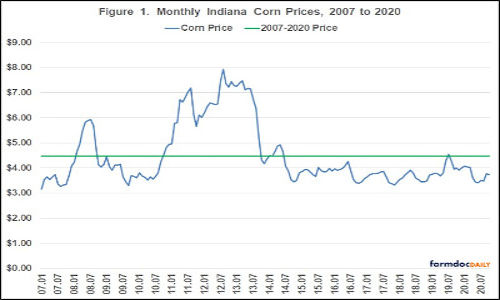
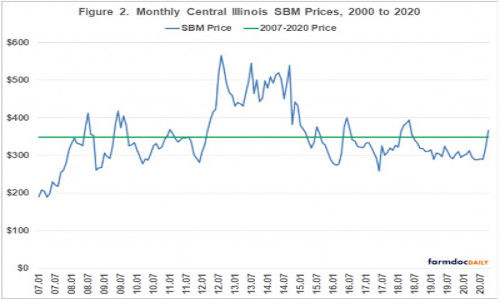
Farrow-to-Finish Enterprise
Figure 3 presents monthly farrow-to-finish feed cost indices from January 2007 to November 2020. The latest full year of indices, 2019, has an index of 100 so all indices outside of this year are expressed in relative terms. The average feed cost index since the beginning of 2007 was 111.9. The index during the last quarter of 2020 is expected to range from 94.0 to 97.4, so feed costs during the fourth quarter of 2020 are expected to be below the average for 2019. However, higher corn prices in the last few months are expected to sharply increase feed cost indices in the next few months. Projected monthly indices for the next 6 months average 105.4 and range from 100.2 in January to 108.5 in June of next year.
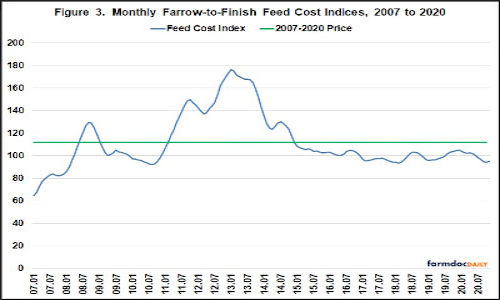
Annual farrow-to-finish feed cost indices are presented in Figure 4. The projection for 2021 used corn and soybean meal futures prices in early December. The projected feed cost index for 2021 is 106.5, which indicates that feed costs in 2021 are expected to be 6.5 percent (7.5 percent) above those experienced in 2019 (2020).
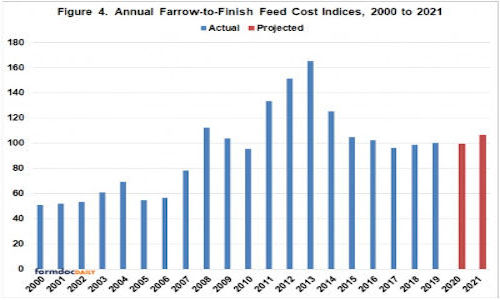
Swine Finishing Enterprise
Figure 5 illustrates monthly swine finishing feed cost indices for the January 2007 to November 2020 period. The latest full year of indices, 2019, has an index of 100 so all indices outside of this year are expressed in relative terms. The average index for the period beginning in 2007 was 109.5. The index for the fourth quarter of 2020 is expected to range from 93.7 to 98.7, so current feed costs are still below those experienced in 2019. Projected monthly feed cost indices for the next 6 months average 106.0 and range from 101.5 in January to 108.1 for June of 2021.
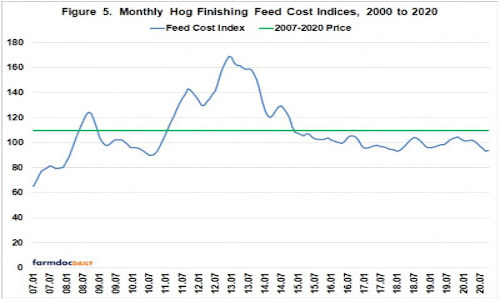
Annual swine finishing feed cost indices are presented in Figure 6. The projection for 2021 used corn and soybean meal futures prices in early December. The projected feed cost index is 106.5, so feed costs in 2021 are expected to be 6.5 percent (8.2 percent) above those experienced in 2019 (2020).
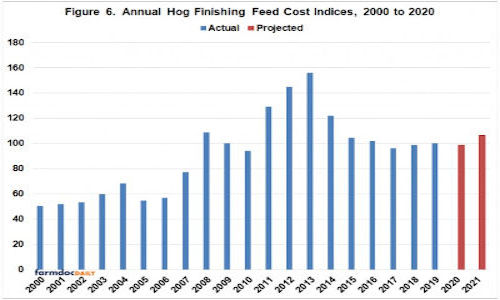
Using the iFarm price distribution tool (here), the probability of the corn futures price for December 2021 being below (above) $3.46 ($4.57) was 25 percent on December 3. This represents a spread of more the $1.10 per bushel. The median expected corn price was $3.98 per bushel. Feed costs are very sensitive to changes in corn and soybean meal prices. Regression analysis was used to examine the relationship between swine finishing feed cost, and corn and soybean meal prices during the January 2007 to December 2019 time period. Results are as follows: each 0.10 increase in corn prices increases feed cost per cwt. by $0.44, and each $10 increase in soybean meal prices increases feed cost per cwt. by $0.32. Obviously, a $0.40 increase or decrease in corn price would have a large impact on feed cost per cwt.
Current feed cost is approximately $31.35 per cwt. Table 1 presents feed cost per cwt. for corn prices ranging from $3.50 to $4.50 per bushel, and soybean meal prices ranging from $350 to $450 per ton. At the lower range of prices, feed cost per cwt. would be approximately $30.65. At the higher range of prices, feed cost per cwt. would be approximately $38.25.
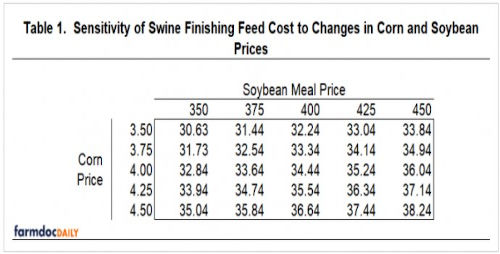
Conclusions
This article discussed recent trends in feed costs for farrow-to-finish and swine finishing enterprises, and provided projections for 2021. Feed costs in 2021 are expected to be approximately 7 to 8 percent above those experienced in 2020. However, current projections have a wide band around them. Current projections use corn prices, depending on the month, ranging from $3.80 to $4.05, and soybean meal prices ranging from $350 to $400 per ton. Corn and soybean prices will be determined by planted acreage as well as other supply and demand factors. Corn prices could be as low as $3.25 to as high as $4.25. This article also examined the impact of changes in corn and soybean meal prices on swine finishing feed cost. Each $0.10 per bushel change in corn price, changes feed cost by $0.44 per cwt. Similarly, each $10 per ton change in soybean meal price, changes feed cost by $0.32 per cwt.
Source : illinois.edu